We view pacific white-sided dolphins both in Knight Inlet on our grizzly bear tour as well as when whale watching in the area of Johnstone Straits.
Killer whales and humpback whales are often seen during our wildlife tours. There are resident whales and transient whales that can be seen feeding and playing in our waters.
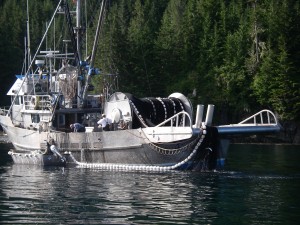
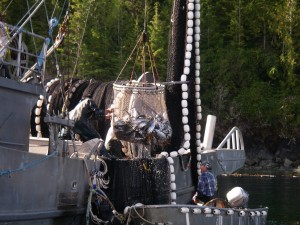
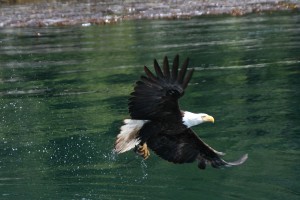 One of the guides, Glen, captures an eagle picking up a fish. You know that it is a good photo when you can zoom in on the eye and it is still sharp and in focus. Eagles are abundant in all our tour areas during the spring and summer; however the numbers decline once the salmon arrive in the local river and the eagle move for closer access to the salmon. That just means there are more eagles on the tour to the grizzly bears on the Glendale River and we have to look a little harder to locate them on a whale watching tour.
One of the guides, Glen, captures an eagle picking up a fish. You know that it is a good photo when you can zoom in on the eye and it is still sharp and in focus. Eagles are abundant in all our tour areas during the spring and summer; however the numbers decline once the salmon arrive in the local river and the eagle move for closer access to the salmon. That just means there are more eagles on the tour to the grizzly bears on the Glendale River and we have to look a little harder to locate them on a whale watching tour.
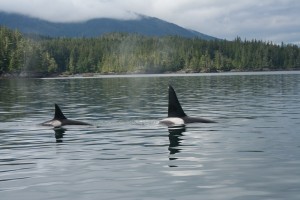 It does not matter what the subject of you photo, when you are on the water, you do not want a bright sunny day. Guests in the lodge are often upset as most mornings are overcast with the clouds burning off by noon. That is the nature of the north coast and that is good. Bright sun reflecting off the water makes for a poor picture whether of a grizzly bear on the shore, eagle in a tree or orca swimming. Most afternoons on the water are spent maneuvering the boat so the sun is at our backs to improve your chance of a good photo.
It does not matter what the subject of you photo, when you are on the water, you do not want a bright sunny day. Guests in the lodge are often upset as most mornings are overcast with the clouds burning off by noon. That is the nature of the north coast and that is good. Bright sun reflecting off the water makes for a poor picture whether of a grizzly bear on the shore, eagle in a tree or orca swimming. Most afternoons on the water are spent maneuvering the boat so the sun is at our backs to improve your chance of a good photo.
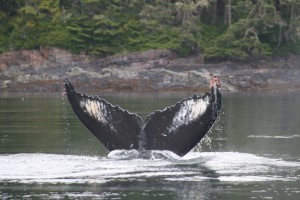 Humpback whales are identified by “Researchers (who) use photographs of the ventral surface of the tail flukes to identify and track movements of individual whales and to estimate abundance. Patterns of pigmentation, scarring and shape of the flukes are unique to each individual.” If you Google “Humpback whale identification” and scroll down to the Fisheries and Oceans Canada site titled “Photographic Catalogue of Humpback Whales in British Columbia” and once in the site scroll to “Photographs and data may not be used without permission. Please refer to “Conditions of Use”” and click on the Conditions of Use and you will have access to their catalogue identifying humpback whales in the lodges viewing area.
Humpback whales are identified by “Researchers (who) use photographs of the ventral surface of the tail flukes to identify and track movements of individual whales and to estimate abundance. Patterns of pigmentation, scarring and shape of the flukes are unique to each individual.” If you Google “Humpback whale identification” and scroll down to the Fisheries and Oceans Canada site titled “Photographic Catalogue of Humpback Whales in British Columbia” and once in the site scroll to “Photographs and data may not be used without permission. Please refer to “Conditions of Use”” and click on the Conditions of Use and you will have access to their catalogue identifying humpback whales in the lodges viewing area.
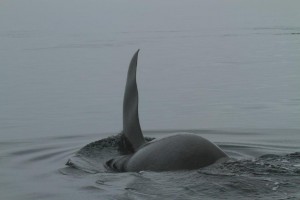
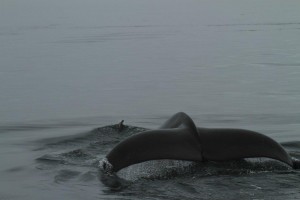
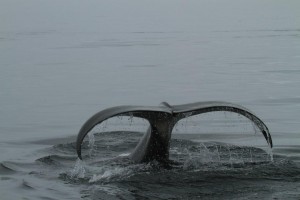 One of my favourite sequence or photos provided by Rob White from Australia. I told him I had to have a set of the photos and was so happy when he obliged with an email. The sequence shows an orca aka “killer whale” passing close to the boat and a guest with a good eye and a fast finger. I have never seen another set of photos like this and I have had many guests over the past twelve years.
One of my favourite sequence or photos provided by Rob White from Australia. I told him I had to have a set of the photos and was so happy when he obliged with an email. The sequence shows an orca aka “killer whale” passing close to the boat and a guest with a good eye and a fast finger. I have never seen another set of photos like this and I have had many guests over the past twelve years.
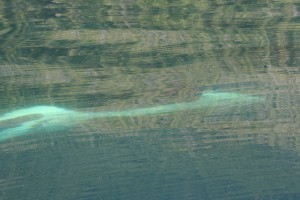 Sitting and waiting is often one of the best strategy during a whale-watching safari. Orcas like their cousin dolphins are curious and will often approach a boat if it is stationary and quite. This orca is on its side looking at the boat as it passes by if it weren’t its dorsal fin would be visible above the surface. Not an every day occurrence but often enough to get good pictures.
Sitting and waiting is often one of the best strategy during a whale-watching safari. Orcas like their cousin dolphins are curious and will often approach a boat if it is stationary and quite. This orca is on its side looking at the boat as it passes by if it weren’t its dorsal fin would be visible above the surface. Not an every day occurrence but often enough to get good pictures.
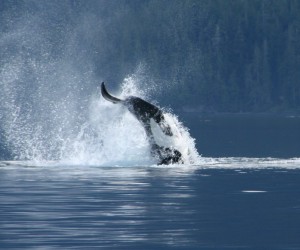

Just like that our season has come to an end. I would like to thank all of our wonderful guests and staff who made this year a huge success. I am happy to stay that all of our team is planning to return next season. We are actively taking bookings, with dates starting June 1 2025. Hope to see many of you next season.
The wildlife viewing this season was awesome. A couple highlights that come to mind was the shear number of salmon in our local rivers, as well as the abundance of Resident Orca. With salmon returns being so strong this year, we were happy to see bears in excellent condition. By the end of our season most of the bears had packed on a lot of weight and were getting very “picky” about what parts of the salmon they would eat. Hopefully this will translate into more cubs being born this winter. Another positive was the weather conditions. We had enough rain to keep our fire risks low and it made for some excellent wild berries. The bears took full advantage of this, with the berry season extending far past its normal conclusion. This did mean that we had to work hard to find bears during our summer season, (as they were often feeding on the berries deep into the forest), but moving forward it is excellent that they had such an abundant food supply. The Humpbacks also didn’t disappoint, with great numbers and a few new calves returning with their mothers to feed. After a slower year for resident Orca sightings, this season was one of the best that I can remember. In fact as Im writing this the A62 and A23’s are still being spotted in the area by dedicated biologists. Strong numbers of Chinook and Chum salmon are providing them with a steady food source. There are a lot of positive signs and we are hopeful that 2025 will be another great season.
Over the winter and spring we will be doing some repairs and maintenance. We plan on having a new cedar front deck built in time for the 2025 season, as well as new ceilings and paint in parts of the lodge and rooms. Theres always projects on the go.
Felix, Julien, Ryan, Zack and Myself all look forward to welcoming guest in June. See everyone soon.
Angus Reid
Visit our Blog